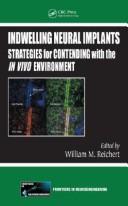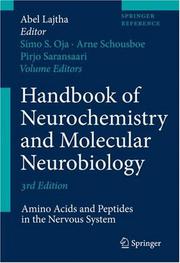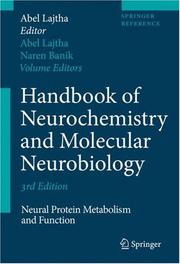| Listing 1 - 4 of 4 |
Sort by
|

ISBN: 0849393620 1322617813 1420009303 042912354X Year: 2007 Publisher: Boca Raton : Taylor & Francis,
Abstract | Keywords | Export | Availability | Bookmark
 Loading...
Loading...Choose an application
- Reference Manager
- EndNote
- RefWorks (Direct export to RefWorks)
Despite enormous advances made in the development of external effector prosthetics over the last quarter century, significant questions remain, especially those concerning signal degradation that occurs with chronically implanted neuroelectrodes. Offering contributions from pioneering researchers in neuroprosthetics and tissue repair, Indwelling Neural Implants: Strategies for Contending with the In Vivo Environment examines many of these challenges, paying particular attention to how the healing of tissues surrounding an implant can impact the intended use of a device. The contributions are
Implants, Artificial. --- Brain. --- Electrodes. --- Foreign-body reaction. --- Nerve tissue. --- Wound healing.

ISBN: 0387303731 0387303421 Year: 2007 Publisher: New York, NY : Springer US : Imprint: Springer,
Abstract | Keywords | Export | Availability | Bookmark
 Loading...
Loading...Choose an application
- Reference Manager
- EndNote
- RefWorks (Direct export to RefWorks)
Nerve tissue proteins. --- Neuropeptides. --- Brain peptides --- Nerve tissue proteins --- Neurotransmitters --- Peptides --- Nerve proteins --- Neural proteins --- Neuroproteins --- Proteins --- Neurosciences. --- Neural sciences --- Neurological sciences --- Neuroscience --- Medical sciences --- Nervous system --- Neuropeptides --- Amino acids --- Metabolism

ISBN: 0387303790 0387303464 Year: 2007 Publisher: New York, NY : Springer US : Imprint: Springer,
Abstract | Keywords | Export | Availability | Bookmark
 Loading...
Loading...Choose an application
- Reference Manager
- EndNote
- RefWorks (Direct export to RefWorks)
Nerve tissue proteins. --- Nerve tissue proteins --- Neurochemistry. --- Molecular neurobiology. --- Metabolism. --- Molecular neurology --- Nervous system --- Molecular biology --- Neurobiology --- Biochemistry --- Neurosciences --- Nerve proteins --- Neural proteins --- Neuroproteins --- Proteins --- Molecular aspects --- Neurosciences. --- Neural sciences --- Neurological sciences --- Neuroscience --- Medical sciences
Book
ISBN: 1280863625 9786610863624 3540698167 3540698159 Year: 2007 Publisher: Berlin, Heidelberg : Springer Berlin Heidelberg : Imprint: Springer,
Abstract | Keywords | Export | Availability | Bookmark
 Loading...
Loading...Choose an application
- Reference Manager
- EndNote
- RefWorks (Direct export to RefWorks)
1 Introduction The prostate causes a significant number of medical problems in the adult male, and the lower urinary tract symptoms are accepted as an unavoidable consequence of male aging. Most of these symptoms are mainly due to clinical benign prostatic hyperplasia (BPH), which is the most frequent benign tumor in the male, independent of race or culture. On the other hand, cancer of the prostate shows an increasing incidence, being the second leading cause of death in men, after lung cancer. It has an etiology related to multiple factors: age, race, androgen dependence, chemical agents, diet, etc. Both pathologies are very costly in terms of medical resources, and they significantly diminish quality of life. More than 400,000 prostate resections per year are done in the US, and these result in an approximate cost of 5 billion dollars per year. Because of all these circumstances, a better knowledge of the mechanisms regulating normal, hyperplastic, and neoplastic prostate growth is important for treatment and prevention of BPH and prostate cancer. Since the last review about prostate neuroendocrine cells published in 1998 there have been new and exciting developments relating to these cells in both normal and pathologic prostate. The cross talk of signals between epithelial and neuroendocrine cells seems relevant to the development and physiopathology of the prostate; thus the relationship between these cell populations should be more deeply studied.
Prostate --- Paraneurons. --- Neuropeptides. --- Innervation. --- Medicine. --- Biomedicine. --- Biomedicine general. --- Clinical sciences --- Medical profession --- Human biology --- Life sciences --- Medical sciences --- Pathology --- Physicians --- Neuroendocrine cells --- Neurons --- Chromaffin cells --- Gland, Prostate --- Glandula prostata --- Prostata --- Prostate gland --- Exocrine glands --- Generative organs, Male --- Brain peptides --- Nerve tissue proteins --- Neurotransmitters --- Peptides --- Biomedicine, general. --- Health Workforce --- Medicine --- Biology --- Biomedical Research. --- Research. --- Biological research --- Biomedical research
| Listing 1 - 4 of 4 |
Sort by
|

 Search
Search Feedback
Feedback About
About Help
Help News
News